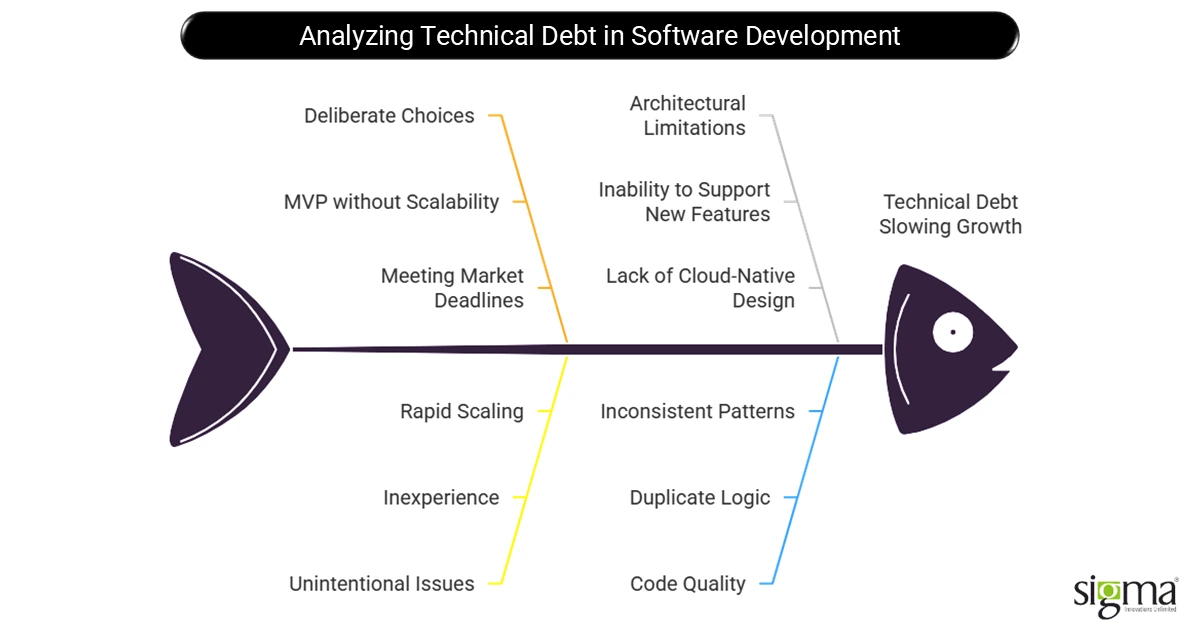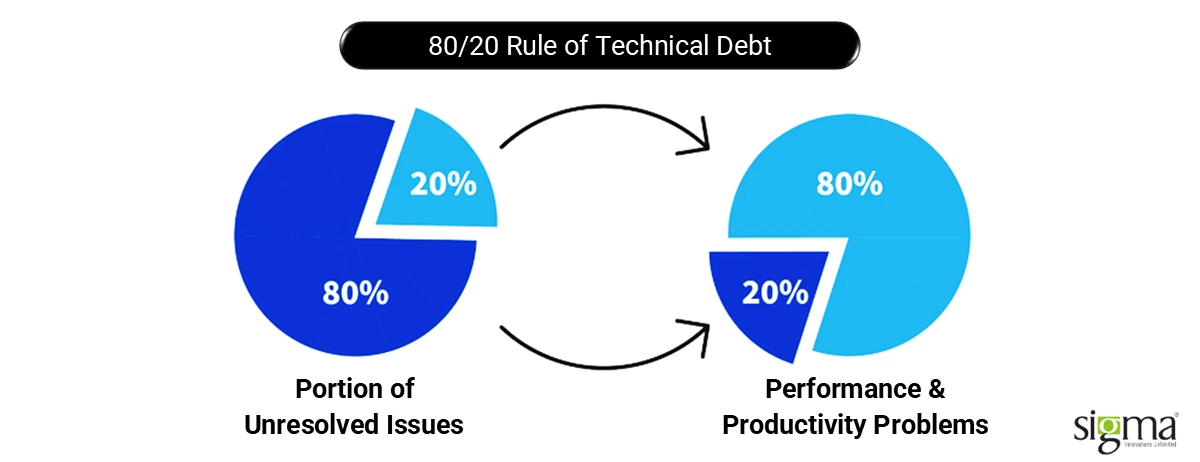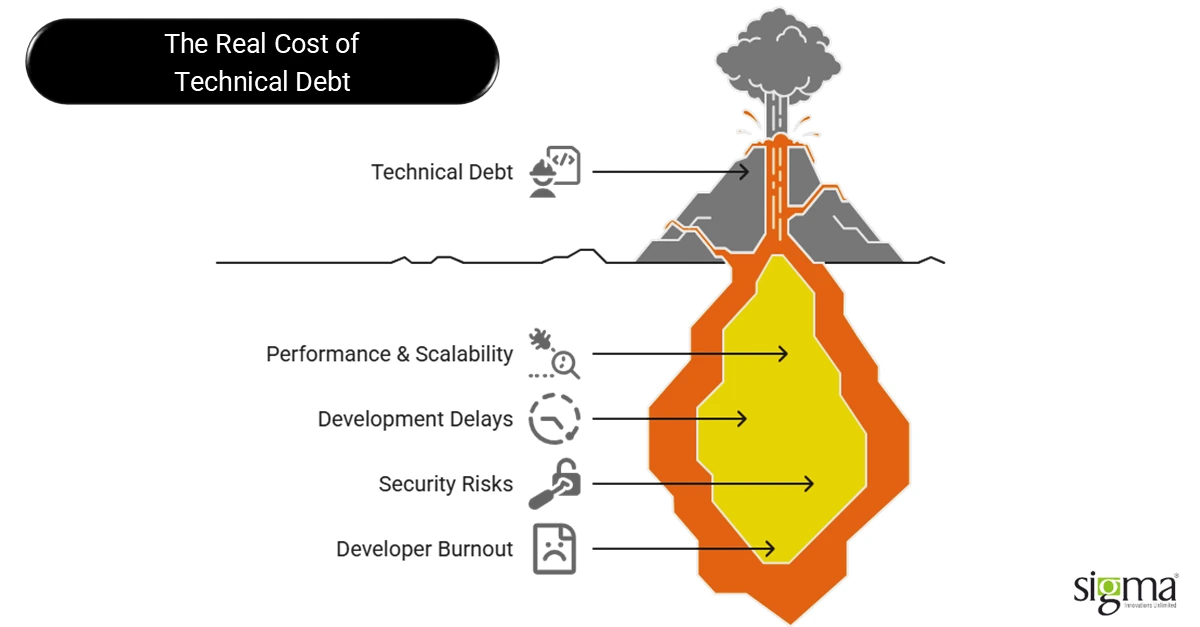Bid Goodbye to Technical Debt with the Best Technology Development Services

Ever feel like your software is held together by duct tape and good intentions? That’s technical debt in action. So, what is technical debt? In simple terms, technical debt is what builds up when companies take shortcuts in software development to meet deadlines. Think of it like skipping oil changes in your car — it may keep moving for a while, but eventually, that neglect adds up, and it’ll cost you more to fix.
In today’s fast-paced digital world, technical debt is becoming a silent business killer for fintech companies and eCommerce businesses.. From clunky code and outdated frameworks to poor UI and UX design services, every bit of ignored technical debt slows your team down and frustrates your users. For FinTech and eCommerce platforms, where seamless performance and trust are everything, the impact of technical debt is multiplied — think checkout glitches, data sync errors, or analytics that just don’t add up.
That’s why eliminating technical debt isn’t just about cleaner code — it’s key to digital transformation, growth, and scalability. Without it, innovation slows down, updates become painful, and user experience takes a hit.
But here’s the good news: you don’t have to tackle it alone. With the right technology development services partner—one who offers solid software product engineering services, Salesforce services, AWS cloud solutions, artificial intelligence development services, and custom development services—you can cut through the clutter, reduce technical debt, and build forward.
Let’s dive in and see how the right partner can turn your tech mess into momentum.
Understanding Technical Debt: What’s Slowing Your Growth?
Let’s break it down: technical debt’s meaning isn’t some mysterious tech buzzword—it’s simply the cost of shortcuts in software development. Much like swiping your credit card for a quick purchase, technical debt gives you something fast, but you’ll pay for it later, with interest.

Types of Technical Debt
There isn’t just one flavor of technical debt. It shows up in several forms:
- Deliberate technical debt: This happens when teams knowingly choose a shortcut—say, shipping an MVP without scalable architecture, just to meet a market launch date. It’s like using training wheels on a racing bike.
Read blog to know more about MVP - Accidental technical debt: When things are moving fast, and your devs just don’t know a better way, this debt sneaks in unnoticed. It often comes from inexperience or rapid scaling without a solid tech strategy.
- Architectural debt: When the foundational system design can’t support new features or integrations. This is common in legacy systems that were never meant to be modern cloud-native or mobile-first.
- Code-level debt: Bad code, duplicate logic, or inconsistent patterns. These slow everything down, from onboarding new developers to deploying updates.
All these forms of technical debt directly affect your eCommerce development services, financial software development services, and even your BI & Analytics development services. They clog the pipes, delay new features, and kill user experience. In line with the 80/20 rule of tech debt, a small portion of unresolved issues often causes the majority of performance and productivity problems—making it essential to address the most impactful debt first.

Why Fast-Scaling Businesses Accumulate Debt?
High-growth companies—especially in eCommerce and FinTech—often take the “build fast, fix later” route. Sound familiar? This is usually driven by:
- MVP pressure – You needed to show something to investors or early adopters yesterday. So you cut corners. Fast.
- Market speed – If competitors are releasing features monthly, you can’t afford to fall behind. But chasing trends can lead to messy backends.
- Lack of documentation – In the rush, documenting code feels like a luxury. But without it, tech debt piles up like clutter in a garage.
- Underinvesting in architecture – Startups often prioritize front-end features over back-end stability. Result? Features that don’t scale.
Think of this like building a house with poor plumbing—sure, it looks great outside, but when the pipes burst under pressure, you’re in deep water.
How Technical Debt Accumulates (and Hurts)
Technical debt is like a hidden burden that quietly accumulates in your software systems. Most businesses don’t realize its impact until they face slowdowns in development, system limitations, or mounting security risks. Here’s a breakdown of the consequences and statistics associated with technical debt:
Key Points:
- Technical debt often goes unnoticed until new features or upgrades expose platform limitations.
- Developers end up spending more time fixing old code than building new capabilities.
- Product releases slow down, bugs increase, and user satisfaction drops—leading to churn.
- Security risks escalate with outdated systems and legacy frameworks, especially for businesses handling sensitive data or operating high-volume eCommerce platforms.
- Early identification of technical debt helps businesses shift from reactive fixes to proactive solutions.
- Common signs of technical debt include outdated architecture, bloated codebases, and lack of documentation.
- A clear understanding of technical debt and its real-world examples is essential to regaining control—strategies for resolution follow in the next section.
The Real Cost of Technical Debt: It’s More Than Just Bad Code
If technical debt were just a little mess in the code, you could live with it. But in reality? It’s more like termites in your tech foundation—unseen, silent, and seriously destructive.

Performance & Scalability? Say Goodbye
As technical debt builds up, your app’s performance takes a nosedive.
Pages load more slowly, transactions lag, and user actions take forever to reflect. In the eCommerce world, even a one-second delay can drop conversions by 7%.
For FinTech platforms, where real-time data matters, that lag can erode trust and credibility.
Scalability also gets handcuffed. Want to add new features or onboard a big client? Good luck. That tangled code from two years ago will need to be untangled first, stalling progress.
Development Gets Slower & More Expensive
One of the most frustrating impacts of technical debt is how it bloats your development timeline. What should’ve been a one-week sprint now turns into three. Teams end up patching old bugs rather than pushing new releases.
The cost of fixing bugs post-release? Still 6x to 15x more than catching them early, as mentioned earlier. Multiply that over time, and you’re draining resources and missing opportunities.
Security Risks: A FinTech Nightmare
For industries handling sensitive financial data, technical debt isn’t just inconvenient—it’s risky. Outdated frameworks and unpatched code create gaps hackers love to exploit. Add in rising compliance requirements, and your business could be staring down fines or worse.
Developer Burnout & Hiring Headaches
Nobody wants to work on spaghetti code. High technical debt leads to frustrated teams, endless firefighting, and eventually, burnout. Onboarding new developers becomes a nightmare when documentation is missing and systems are fragile. Retaining top talent becomes harder, and your velocity slows even more.
Modern Ways to Tackle Technical Debt (Without Losing Sleep)
Here’s the good news—technical debt isn’t a life sentence. With the right mindset and tools, businesses can dig themselves out and stay ahead. Let’s look at how today’s smartest tech teams are doing it.
Refactoring: Like Spring Cleaning for Your Code
Refactoring is all about cleaning up messy code without changing what it does. It’s like renovating your house—new plumbing, stronger walls, same layout. When done regularly, it prevents small issues from becoming big disasters.
Smart businesses work with custom development services teams that prioritize modular, clean code. This makes it easier to update, scale, and build on top of, especially important for platforms offering eCommerce development services and financial software development services.
CI/CD: Move Fast, But with Guardrails
Continuous Integration and Continuous Deployment (CI/CD) pipelines help development teams catch issues early and release updates fast without breaking stuff. Think of it as a self-checkout system for your code—changes are automatically tested and deployed.
By setting up CI/CD, businesses get to reduce technical debt while speeding up release cycles. It’s especially useful in high-growth environments like FinTech, where agility and security go hand in hand.
AI & Automation: Your Smart Tech Wingmen
Today’s technology development services providers are leaning into Artificial Intelligence development services to identify technical debt examples faster than ever. AI-powered tools scan codebases for inefficiencies, outdated libraries, and risky patterns.
Automation doesn’t just speed up detection—it helps with remediation too. Whether it’s suggesting cleaner code or identifying forgotten dependencies, AI is now the co-pilot for proactive dev teams.
Architecture & Code Reviews: Build Right From the Start
Preventing technical debt starts way before a single line of code is written. A strong foundation through scalable software product engineering services and thoughtful architecture planning sets the stage.
Regular code reviews are another best practice. They bring fresh eyes to the table and ensure no one’s quietly building future debt. Combining human insight with tools like static code analyzers is the sweet spot.
And let’s not forget documentation—keeping it updated is still one of the easiest ways to avoid accidental debt down the road.
Bottom line? You don’t need to fear technical debt. With the right approach—refactoring, automation, smart reviews, and a solid CI/CD strategy—you can stay lean, agile, and future-ready.
Why a Strategic Tech Partner Is Your Best Bet Against Technical Debt
You don’t have to fight technical debt alone. Trying to solve it with an overstretched in-house team is like using a sponge to bail out a sinking boat. You need a partner—one with deep tech know-how and a forward-thinking approach to technology development services.
Clean Code, Solid Architecture, and Smart Documentation
Great development partners don’t just fix bugs—they stop them from forming in the first place. Through industry-best practices like clean coding standards, modular architecture, and updated documentation, expert teams keep your foundation solid. That’s true whether it’s software development services, eCommerce development services, or financial software development services.
They bring in structured code reviews, pair programming, and automated testing, keeping your systems lean and future-proof. When paired with custom development services or AWS cloud solutions, this foundation ensures your digital product is ready to grow, scale, and pivot without breaking under pressure.
Outsourcing: Fast, Flexible, and Cost-Effective
Outsourcing your development work can save you serious time and money. Instead of hiring, training, and retaining an in-house team, you can plug into a ready-to-go team with specialized UI and UX design services, Salesforce services, and BI & Analytics development services.
For example, a mid-sized online retailer recently offloaded years of technical debt by working with a software product engineering services firm, Sigma Infosolutions. In just 90 days, they improved load times by 42% and reduced cart abandonment by over 25%. A FinTech lending platform, meanwhile, cut its feature release cycle in half by shifting to a partner-led CI/CD model.
The right technology development services partner isn’t just a vendor—they’re your debt destroyers, performance boosters, and innovation accelerators.
How Our Development Services Tackle Technical Debt—For Good
At Sigma Infosolutions, we’ve seen firsthand how technical debt can slow businesses down. Whether you’re running an online store or building the next big FinTech platform, technical debt shows up like clutter in a garage—it starts small but grows fast. That’s why our technology development services are built to do more than just keep your systems running. We help eliminate technical debt at its roots—so you can scale without stress.
eCommerce Development Services: Clean, Scalable, and Built to Perform
From Magento to Shopify to BigCommerce, our eCommerce development services are engineered for performance and peace of mind. We follow clean coding practices, modular design, and extensible architecture, which means fewer bugs and faster go-to-market cycles.
Want to launch a new feature or integrate with a payment gateway? No problem. Our scalable setups make it easy to extend functionality without breaking what’s already there. We also perform proactive code reviews and audits to ensure your store doesn’t silently collect technical debt behind the scenes.
FinTech Services: Built With Security and Compliance First
In FinTech, the stakes are higher—technical slip-ups can lead to serious compliance issues. Our financial software development services focus on secure, modular product engineering built for modern needs.
We specialize in integrating with third-party systems like KYC, fraud detection, payment processors, and lending engines. From real-time credit assessments to data-driven dashboards, our solutions are tailored to fit FinTech workflows while eliminating fragile or outdated codebases.
We stay on top of compliance requirements and make sure your architecture can handle scale, data privacy, and audits—so you can focus on innovation.
Software Engineering Done Right: DevOps, Cloud, and Automation
We go beyond the basics with full-stack software product engineering services, DevOps, and AWS cloud solutions. Using microservices, serverless patterns, and CI/CD pipelines, we create cloud-native products that are easy to deploy, maintain, and scale.
Our code quality benchmarks are strict—backed by peer reviews, static code analysis, and automated testing. This means fewer bugs, less rework, and more time spent building what matters.
Technical Debt? We Hunt It Down and Wipe It Out
Our team regularly conducts technical audits to identify hidden inefficiencies and technical debt examples. Whether it’s spaghetti code, outdated libraries, or poor documentation—we fix what’s broken and future-proof what works.
We also offer tech stack modernization and legacy transformation services—helping businesses migrate from old-school systems to modern, agile, cloud-based platforms. It’s like swapping out your flip phone for a smartphone—instant upgrade in speed, usability, and potential.
When you partner with us, you’re not just getting code—you’re getting clean, reliable, and strategic technology development services designed to keep technical debt out of your way for good.
Future-Proofing Your Tech Stack Against Technical Debt
If technical debt is the silent killer of innovation, future-proofing your stack is like giving your tech team a seatbelt and airbag before hitting the highway. In today’s fast-paced tech world, tools are evolving, trends are shifting, and expectations are rising. The only way to stay ahead? Think long-term and build smarter from the ground up.
Emerging Tech Trends That Keep Debt at Bay
Software development is constantly changing, and new technologies help businesses build strong, scalable apps while reducing technical debt. Here’s how some of the most impactful trends are helping organizations stay ahead of the curve:
- AI-assisted coding acts as a smart co-pilot—identifying logic flaws, suggesting improvements, and automating test cases.
- Low-code/no-code platforms enable rapid MVP development, simplifying internal dashboards, workflow automation, and app integrations.
- MACH architecture (Microservices, API-first, Cloud-native, Headless) supports modular builds, enabling faster scaling and issue isolation.
- Serverless deployments streamline rollouts, allowing developers to deploy updates and handle traffic spikes without infrastructure concerns.
- Combined with expert tech development services, these tools don’t just reduce tech debt—they position teams to innovate faster and more confidently.
How Business Leaders Can Set the Tone
If you’re a CTO, CIO, or business leader, future-proofing your stack starts with mindset. Encourage your teams to view code like a living organism—it needs care, upgrades, and occasional surgery.
Here’s how you create a culture of tech health:
- Prioritize maintainability over quick fixes.
- Budget for software development services that include testing, reviews, and architectural upgrades.
- Track metrics around code quality, velocity, and technical debt.
- Collaborate with partners who understand your domain—whether it’s financial software development services or eCommerce development services.
When leadership embraces quality over quantity, the ripple effect touches every line of code.
Always Be Evolving
The “build fast and fix later” mindset has led to some of the most well-known failures in tech history.
Take Knight Capital, for instance—its outdated and poorly maintained codebase resulted in a $440 million trading loss in just 45 minutes. Similarly, the UK’s TSB bank migration fiasco locked millions of customers out of their accounts, all due to legacy systems and accumulated technical debt.
Source: Sigrid
These examples underscore why today’s top-performing teams embrace a culture of continuous improvement. They regularly refactor code, leverage automation thoughtfully, and rely on BI & Analytics development services to measure progress and prevent issues before they escalate.
Even UI and UX design services play a key role—adapting in real time to user behavior and feedback ensures products stay intuitive, engaging, and free from experience-related debt.
Future-proofing your tech stack isn’t a one-off task—it’s a sustained culture shift. With the right technology development services in place, this mindset becomes your greatest competitive advantage.
Turn Technical Debt Into Your Next Growth Opportunity
Let’s face it—technical debt isn’t just a developer headache. It’s a business bottleneck. From sluggish performance and missed release dates to frustrated users and compliance risks, the ripple effects can be huge—especially in fast-moving industries like eCommerce and FinTech.
The good news? You’re not stuck with it. With the right technology development services—including software product engineering, custom development services, AWS cloud solutions, UI and UX design services, and Artificial Intelligence development services—you can fix what’s slowing you down and build a future-ready tech foundation.
The smartest companies don’t just manage debt—they eliminate it proactively. They invest in clean architecture, scalable systems, secure code, and data-driven decision-making with BI & Analytics development services. Whether you’re running an online retail platform or a lending engine, technical debt shouldn’t be holding you back.
Looking to boost efficiency, scalability, and innovation? Partner with a team that understands the unique demands of your business and has deep experience in FinTech software development services. Let’s work together to turn tech challenges into growth drivers.
